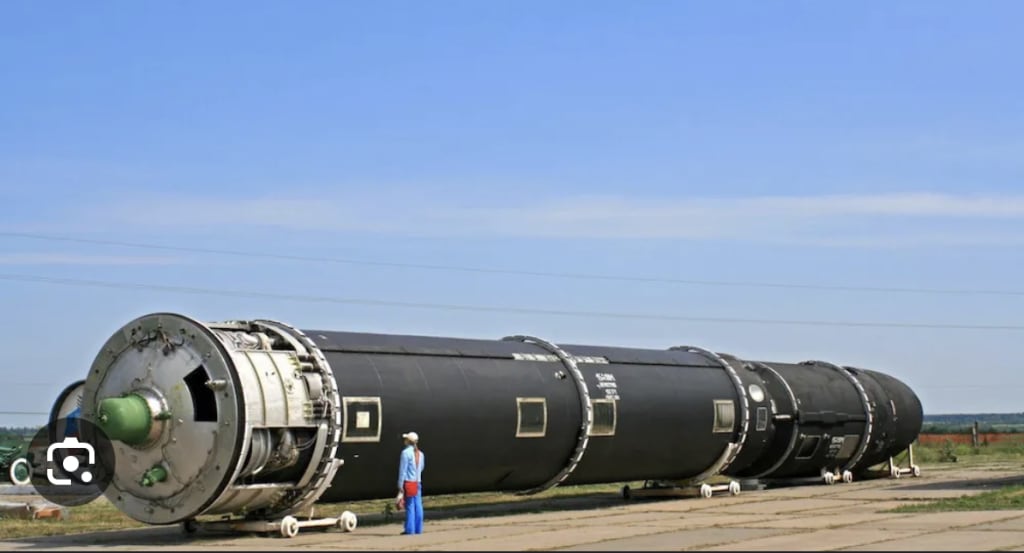
Title: RS-28 Sarmat: The Dawn of a New Era in Intercontinental Ballistic Missile Technology
Introduction:
In an age defined by technological advancements and strategic deterrence, the RS-28 Sarmat stands as a testament to human ingenuity and the relentless pursuit of military supremacy. Developed by Russia, the RS-28 Sarmat is a next-generation intercontinental ballistic missile (ICBM) designed to replace its predecessor, the R-36M2 Voevoda. With its advanced capabilities, the Sarmat promises to reshape the global strategic landscape, making it a topic of significant interest and concern among military analysts and policymakers worldwide. This essay explores the key features, implications, and potential ramifications of the RS-28 Sarmat as a formidable weapon system.
Body:
1. Historical Background:
To appreciate the significance of the RS-28 Sarmat, it is essential to understand its historical lineage. The Sarmat's origins can be traced back to the Cold War era when the Soviet Union sought to develop a reliable ICBM capable of delivering a devastating nuclear payload to distant targets. The R-36M2 Voevoda, often referred to as "Satan," served as the Soviet Union's premier ICBM. However, with the passage of time, advancements in missile defense systems necessitated the development of a more sophisticated and advanced weapon system. Enter the RS-28 Sarmat.
2. Key Features and Capabilities:
The RS-28 Sarmat embodies an array of cutting-edge features that render it a formidable weapon system. Firstly, it possesses an unparalleled range of up to 18,000 kilometers (11,185 miles), enabling it to strike targets anywhere on the planet with pinpoint accuracy. Furthermore, the Sarmat is equipped with multiple independently targetable reentry vehicles (MIRVs) capable of carrying ten or more nuclear warheads, each capable of evading missile defense systems. This feature significantly enhances the Sarmat's effectiveness by enabling it to overwhelm enemy missile defenses. Additionally, the Sarmat incorporates advanced stealth technology, making it difficult to detect and track, further elevating its potency as a strategic deterrent.
3. Implications for Global Security:
The introduction of the RS-28 Sarmat carries profound implications for global security and the delicate balance of power among nations. On one hand, Russia's development of the Sarmat is viewed as a demonstration of its commitment to maintaining a credible deterrence capability, thereby safeguarding its national security interests. The Sarmat's extended range, coupled with its MIRV capability, ensures that Russia can engage in retaliatory strikes even if a significant portion of its arsenal is neutralized. Consequently, this enhances Russia's ability to deter potential adversaries and protect its sovereignty.
On the other hand, the RS-28 Sarmat raises concerns among other nations and within the arms control community. The Sarmat's advanced features and increased payload capacity challenge existing missile defense systems, potentially tipping the scales in favor of offensive capabilities. This, in turn, creates an incentive for other nations to bolster their own missile defense capabilities, leading to an arms race in space-based and land-based defense systems. The resulting escalation poses a threat to global stability and increases the risk of miscalculation or accidental conflict.
4. Potential Ramifications:
The deployment of the RS-28 Sarmat is expected to have a significant impact on arms control agreements and non-proliferation efforts. Existing arms control treaties, such as the Strategic Arms Reduction Treaty (START), may require revisions to account for the Sarmat's enhanced capabilities and the potential increase in the number of warheads it can carry. This, in turn, places further strain on arms control efforts, potentially undermining the progress made in arms reduction and non-proliferation over the years. The RS-28 Sarmat's introduction into the strategic arsenal also raises questions about the stability of the nuclear deterrence paradigm. As the Sarmat's capabilities surpass those of its predecessors, it could potentially disrupt the delicate balance that has maintained relative peace during the Cold War and beyond.
Furthermore, the development and deployment of the RS-28 Sarmat may have broader geopolitical implications. Russia's demonstration of advanced missile technology sends a clear message to other global powers, signaling its continued relevance and military prowess. It could potentially shift the power dynamics among nations and prompt others to reevaluate their own military capabilities and modernization plans. This, in turn, may lead to an increase in defense spending and strategic repositioning, fueling further tension and competition in international relations.
The RS-28 Sarmat also raises ethical concerns surrounding the use of nuclear weapons. The increased payload capacity and potential for MIRVs heighten the destructive potential of the missile, amplifying the catastrophic consequences of a nuclear exchange. As such, it underscores the urgent need for renewed efforts toward disarmament, arms control, and the pursuit of peaceful resolutions to conflicts.
It is worth noting that the RS-28 Sarmat's impact extends beyond its military capabilities. The development and deployment of such advanced technology require significant financial and technological investments. These resources could have been allocated toward addressing pressing global challenges such as poverty, climate change, or healthcare. The prioritization of military advancements raises questions about resource allocation and the long-term sustainability of global security.
Conclusion:
The RS-28 Sarmat represents a leap forward in intercontinental ballistic missile technology, with its advanced features and capabilities. While it strengthens Russia's strategic deterrence and bolsters its national security, it also raises concerns and challenges existing arms control efforts. The implications of the Sarmat's deployment extend beyond military capabilities, impacting geopolitics, disarmament efforts, and resource allocation.
The international community must address the challenges posed by the RS-28 Sarmat by fostering open and transparent dialogue, revitalizing arms control agreements, and recommitting to nuclear disarmament. By prioritizing diplomatic solutions, confidence-building measures, and multilateral cooperation, nations can navigate the complexities of emerging technologies while working toward a safer and more secure world. The RS-28 Sarmat serves as a stark reminder of the importance of collective action and the urgent need for strategic stability in a rapidly evolving global landscape.
About the Creator
Enjoyed the story? Support the Creator.
Subscribe for free to receive all their stories in your feed. You could also pledge your support or give them a one-off tip, letting them know you appreciate their work.





Comments
There are no comments for this story
Be the first to respond and start the conversation.